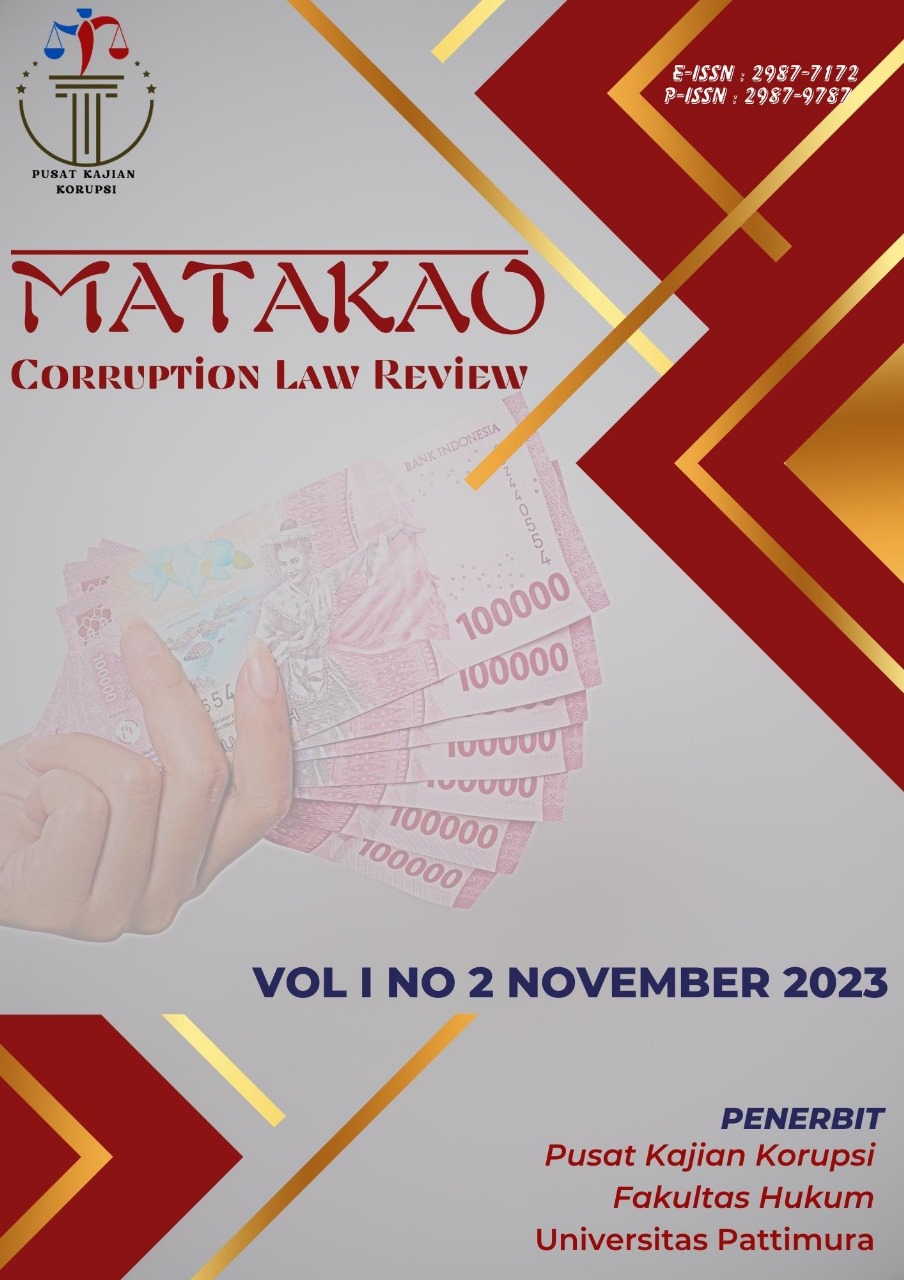Penegakan Hukum Terhadap Asset Recovery Tindak Pidana Korupsi Di Indonesia
Abstract
Introduction: Corruption crimes in Indonesia continue to increase and have become a complex problem for law enforcement officials, both in terms of the number of cases and state financial losses, as well as in terms of the quality of criminal acts. The uncontrolled increase in criminal acts of corruption can result in disaster for national economic life and the life of the nation and state. The magnitude of state financial losses resulting from criminal acts of corruption is very disproportionate to the magnitude of returns to state financial losses resulting from corruption. It is hoped that the appropriate use of state confiscated goods can be implemented well by Ministries/Agencies and Regional Governments for the benefit of government administration. In addition to corporate punishment for perpetrators of criminal acts of corruption, the Corruption Eradication Commission also provides a deterrent effect by confiscating assets. Furthermore, the confiscated assets will be managed as best as possible through a storage mechanism.Purposes of the Research: The aim of this research is to examine law enforcement regarding asset recovery in IndonesiaMethods of the Research: This paper uses the statutory approach, conceptual approach and philosophical approach.Results of the Research: Talking about asset recovery itself is not clearly explained in Law Number 17 of 2003 concerning State Finances and Law Number 1 of 2004 concerning State Treasury or in Law Number 31 of 1999 Jo. Law Number 20 of 2001 concerning the Eradication of Corruption Crimes. In this case, asset recovery is a solution in order to eradicate criminal acts of corruption to recover losses resulting from actions carried out by perpetrators of criminal acts of corruption. State losses caused by perpetrators created Law Number 3 of 1971 as well as new regulations, namely Law Number 31 of 1999 in conjunction with Law Number 20 of 2001 stating a policy where state losses must be returned or replaced by the perpetrator or asset recovery. The essence of eradicating criminal acts of corruption can be divided into 3 (three) things, namely through preventive action, repressive and restorative action. Preventive measures are related to regulations to eradicate criminal acts of corruption with the hope that the public will not commit criminal acts of corruption. Restorative action, one of which is the return of assets of perpetrators of criminal acts of corruption in the form of criminal legal action and civil lawsuits. Management of confiscated goods has a strategic role in the context of asset recovery efforts for criminal acts. Management of confiscated goods has a strategic role in the context of asset recovery efforts for criminal acts. Management of confiscated goods is the end of the chain of criminal asset recovery processes. Optimizing the management of confiscated goods will influence the output of the stages of the asset recovery process that have been carried out. To achieve this goal, management of confiscated goods must be carried out by paying attention to both law enforcement aspects and asset management aspects. The law enforcement aspect is the core of the asset recovery process. This process is carried out by law enforcement officials as part of the legal process carried out in the context of handling a criminal case. As it develops, the handling of criminal cases is carried out not only to punish the perpetrators of criminal acts but also to restore as much as possible the losses caused by the criminal acts committed.
Downloads
References
Basrief Arief, Pemulihan Aset Hasil Kejahatandalam Pemberantasan Tindak Pidana Korupsi,Workshop Pemulihan Aset Tindak Pidana, Mahupiki, Jakarta, 28-29 Agustus 2014.
Evi Hartanti, Tindak Pidana Korupsi, Edisi Kedua, Jakarta : Sinar Grafika, 2007.
Copyright (c) 2023 Anna Maria Salamor (Author)

This work is licensed under a Creative Commons Attribution-NonCommercial 4.0 International License.
Copyright:
Authors who publish their manuscripts in this Journal agree to the following conditions:
- The copyright in each article belongs to the author, as well as the right to patent.
- Authors are able to enter into separate, additional contractual arrangements for the non-exclusive distribution of the journal's published version of the work (e.g., post it to an institutional repository or publish it in a book), with an acknowledgment of its initial publication in this journal.
- Authors are permitted and encouraged to post their work online (e.g., in institutional repositories or on their website) prior to and during the submission process, as it can lead to productive exchanges, as well as earlier and greater citation of published work.
- Authors have the right to self-archiving of the article (Author Self-Archiving Policy)
Licence : This Journal is disseminated based on the Creative Commons Attribution-NonCommercial 4.0 International license terms. This license allows anyone to copy and redistribute this material in any form or format, compose, modify, and make derivatives of this material for any purpose. You cannot use this material for commercial purposes. You must specify an appropriate name, include a link to the license, and certify that any changes have been made. You can do this in a way that is appropriate, but does not imply that the licensor supports you or your use.

This work is licensed under a Creative Commons Attribution-NonCommercial 4.0 International License..












